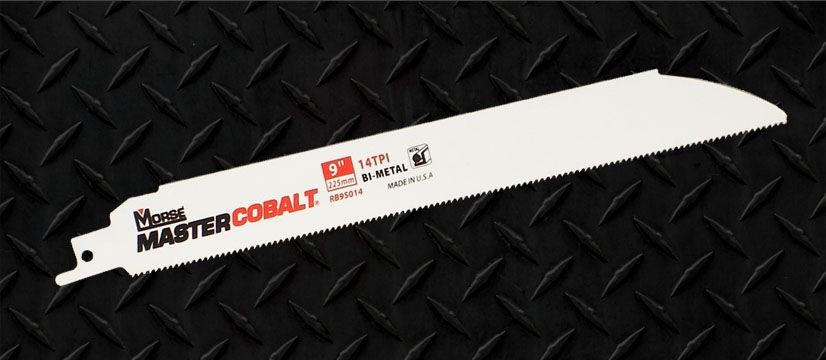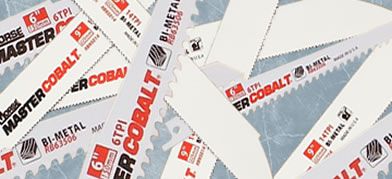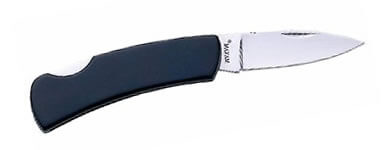How to Select the Best Reciprocating Saw Blades
Reciprocating Saw Blades - Buying Guide
How to Select the Best Reciprocating Saw BladesReciprocating saws are one of the most versatile tools available. Part of that versatility comes from the vast array of blades available for cutting through a wide range of materials. With the right blade, your sawzall can cut through wood, nails, fiberglass, branches, plaster, masonry, and metals including aluminum, cast iron, steel, and even high-strength alloys. But how do you choose the proper blade for the material you need to cut? There are many blade characteristics to consider. In general, this includes the blade material, length, width, thickness, and teeth-per-inch (TPI). For specific cut types, blade shape, tooth shape, kerf-width, gullet, and tooth pattern can be selected. Even though there are many options, choosing the right reciprocating saw blade is easy once you know the basics. Blade MaterialHigh Carbon Steel (HCS)Carbon steel blades are the most inexpensive type, and also the most common. They are the softest of the blade materials and tend to be more flexible to allow bending without breaking in the proper application. That also makes them the least durable. They are good for cutting softer wood, particle board, and plastics. However, they quickly become dull when used on hard woods, metal, and other hard materials. High Speed Steel (HSS)High-speed steel blades are subjected to a tempering process that makes them more heat-resistant and durable than their carbon steel counterparts. They last up to 5 times longer than carbon steel. That hardness makes them less flexible and thus more prone to breaking when bent. It also allows them to cut hardwoods, aluminum, and non-ferrous metal without excessive wear, dulling, and tooth breakage. Bi-Metal
Bi-metal blades combine a high-carbon steel body for flexibility and break-resistance, and high-speed steel teeth for heat-resistance, hardness, and durability. On average, Bi-metal recip blades will last 10 times longer than a carbon steel blade. While the cost slightly more than HSS or HCS blades, they offer the versatility and toughness for more demanding applications. This makes them the most popular blade type among people in the trades, auto yards, and other professions where sawzalls see frequent or daily use. We also recommend bi-metal blades for DIY projects and occasional use because of their durability and long life. Other bi-metal blades use a cobalt-steel alloy cutting edge. This provides even greater heat-resistance, wear-resistance, and overall longer blade life. These blades are suitable for a range of jobs including demolition (nail-embedded wood), auto dismantling, sheet metal and pipe cutting, as well as standard wood cutting. Carbide-Tipped
Carbide tipped sawzall blades are also bi-metal blades, but with a carbide (tungsten carbide or titanium carbide) tip at the end of each tooth. These carbide materials are extremely hard, heat-resistant, and impact-resistant. They also offer 20 times the cutting life of a standard bi-metal blade. The can cut thicker pieces of metal including cast iron, stainless steel, and high-strength alloys. This makes them ideal for cutting metals that would almost immediately destroy a HCS, HSS, or traditional bi-metal blade, such as grade 8 bolts and boron reinforced auto pillars. Carbide GritCarbide grit blades (typically tungsten carbide) don't have teeth like a traditional sawzall blade. They have an abrasive strip that is used for cutting dense materials such as ceramic tile, cement, brick, marble, other stone and masonry, harder metals like cast iron, and fiberglass. The hardness of the carbide grit allows it to cut these materials without damaging them or wearing out prematurely. DiamondDiamond blades are also abrasive, but use diamonds instead of carbide. These are the most expensive reciprocating saw blades. They are used to cut concrete, glass, fiberglass, and ceramic, and can also cut fiber cement, cast iron, and masonry. The hardness of diamonds and fineness of the abrasive grit is necessary to cut brittle material like glass (that would be destroyed by a toothed blade) and very hard and dense material like concrete (that would destroy a toothed blade). Due to the hardness of diamonds, diamond grit blades have a much faster cut than carbide grit and last 5 to 20 times longer.
Pro Tip: LengthReciprocating saw blade lengths range from 3" - 12". Standard lengths are 4”, 6”, 8”, 9” & 12”, with 6" and 9" being the most commonly sold. Short blades are more rigid and therefore more aggressive. That rigidity give you a straighter, more square cut, making them ideal for plunge cutting, copper pipe, and thinner metals. Longer blades are more flexible and can dissipate more heat since they have more surface area. Jobs like demolition, pruning, auto-dismantling, and rescue call for a longer blade. This flexibility also allows you to bend the blade when a flush cut is required. The blade length you choose should always be slightly longer than the thickness of the material you are cutting. This reduces slipping and binding, and allows you some freedom of movement. If you get a blade that is too long the end can wobble, sometimes violently. This causes intense vibration, slowing down your cut, and can ultimately damage your work and lead to a bent blade.
Pro Tip: Width & Shape
Wider blades offer more stability. They resist bending and vibration to provide straighter, more aggressive cuts. That extra support makes wider blades better for heavy duty applications such as demolition (nail-embedded wood), auto-dismantling, and fire & rescue. 3/4" - 1" are considered wide blades. Blades with a lower width provide more flexibility for general purpose use or finer cutting. These typically fall within the 1/2" - 3/4" range. Very low widths are less than 1/2" thick and are typically used for scroll cutting - curved shapes and detail work in wood, metal, and plastic. The blade's shape also makes a difference. Sloped shaped blades are better for plunge cutting. Straight blades are for edge cutting. Many blades have a notched or sloped tip, or a semi-tapered back, to make them able to perform both tasks adequately. ThicknessStandard reciprocating saw blade thicknesses:
Thicker blades are more durable and resist bending and vibration. They also allow a heavier feed pressure for tougher jobs. Heavy duty thicknesses of 0.050" - 0.062" are best for demolition through nail-embedded wood, auto-dismantling, fire & rescue, and cutting thicker or denser metals. Heavy duty blades are rigid and have a larger
General purpose blades are typically 0.035" and are suitable for most applications. They are more flexible and provide a faster cut. They also tend to cost less because less material is used in their construction.
Pro Tip: Teeth-Per-Inch (TPI)Reciprocating saw blades range from 3 - 24 TPI. The number of teeth per inch determines the cut speed and roughness of the cut. Lower TPI blades cut fast but leave rougher edges. Blades in the 3 - 11 TPI range are typically best for wood and demolition work. Pruning blades tend to be at the low end, and demolition/nail-eating blades tend to be around 8-11 TPI. General purpose wood cutting blades are in the middle, often around 6 TPI, and can also cut nails. Blades with higher TPI remove smaller amounts of material with each pass. Therefore they cut slower and leave a much smoother edge. Blades 12-18 TPI are typically used for metal and denser materials as well as finish cuts in wood. The 18-24 TPI range is almost always used for metal cutting.
Pro Tip: Combination blades have a variable TPI and are often used for both wood and metal cutting, and demolition. Different areas of the blade have different TPI, allowing the user to change the cut based on how they position the blade. For example, a 10/14 TPI blade has alternating sections of 10 TPI and 14 TPI for cutting wood and metal. A variable 14/18 TPI blade is designed to chew through metal. Frequently Asked QuestionsWhat are the best sawzall blades for metal? What are the different reciprocating saw blade types? What are the best reciprocating saw blades for wood? Who are the different saw blade manufacturers? What is the right sawzall blade for fiberglass? What is the best sawzall blade for hardened steel? Are reciprocating saw blades universal / interchangeable? Do I need special plaster sawzall blades? Do I need a special PVC sawzall blade? Reciprocating Saw Blade Glossary of Terms |


